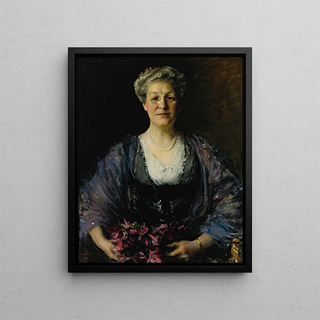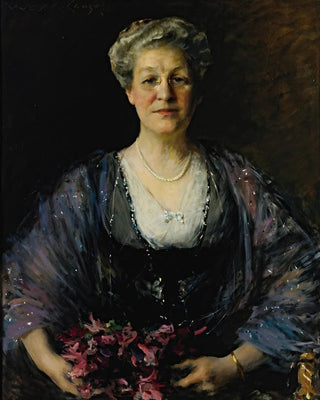Art print | Portrait of Matilda Herbert Lloyd 1855-1945 - William Merritt Chase Source: Reproduction | Portrait de Matilda Herbert Lloyd 1855-1945 - William Merritt Chase


View from behind

Frame (optional)
Captivating Introduction
The "Portrait of Matilda Herbert Lloyd" by William Merritt Chase is a work that transcends the simple frame of a portrait to delve into a deeper reflection on the human condition and intimacy. Painted in 1895, this painting evokes an era when female representation was both a mirror of society and an exploration of personal emotions. The artist, with his mastery of colors and textures, manages to capture the very essence of his model, offering the viewer a window into a unique personality. The art print of this masterpiece allows for a rediscovery of the beauty and complexity of life through the lens of a visionary artist.
Style and uniqueness of the work
William Merritt Chase's style is characterized by an impressionist approach, where light and color play a crucial role. In the "Portrait of Matilda Herbert Lloyd," we observe a bold use of tones that give the canvas a vibrant and warm atmosphere. The brushstrokes, both delicate and assertive, create a rich, almost tangible texture that draws the eye and invites exploration. The background, carefully crafted, highlights the model while hinting at a certain depth, suggesting a world beyond mere representation. Matilda's posture, both natural and posed, conveys timeless elegance, while her delicate expression evokes an introspection that touches on the universal. Chase succeeds in establishing a dialogue between his subject and the viewer, making each look at the work unique and personal.
The artist and his influence
William Merritt Chase, an iconic figure of the American impressionist movement, left his mark on his era with his innovative vision and bold approach to painting. Born in 1849, he was influenced by European masters while developing a style that was uniquely his own. Chase not only contributed to the evolution of portrait painting but also played a key role in art education, training many artists who continued his legacy. His work, often centered on light and color, paved the way for a new way of perceiving artistic representation.

Matte finish

View from behind

Frame (optional)
Captivating Introduction
The "Portrait of Matilda Herbert Lloyd" by William Merritt Chase is a work that transcends the simple frame of a portrait to delve into a deeper reflection on the human condition and intimacy. Painted in 1895, this painting evokes an era when female representation was both a mirror of society and an exploration of personal emotions. The artist, with his mastery of colors and textures, manages to capture the very essence of his model, offering the viewer a window into a unique personality. The art print of this masterpiece allows for a rediscovery of the beauty and complexity of life through the lens of a visionary artist.
Style and uniqueness of the work
William Merritt Chase's style is characterized by an impressionist approach, where light and color play a crucial role. In the "Portrait of Matilda Herbert Lloyd," we observe a bold use of tones that give the canvas a vibrant and warm atmosphere. The brushstrokes, both delicate and assertive, create a rich, almost tangible texture that draws the eye and invites exploration. The background, carefully crafted, highlights the model while hinting at a certain depth, suggesting a world beyond mere representation. Matilda's posture, both natural and posed, conveys timeless elegance, while her delicate expression evokes an introspection that touches on the universal. Chase succeeds in establishing a dialogue between his subject and the viewer, making each look at the work unique and personal.
The artist and his influence
William Merritt Chase, an iconic figure of the American impressionist movement, left his mark on his era with his innovative vision and bold approach to painting. Born in 1849, he was influenced by European masters while developing a style that was uniquely his own. Chase not only contributed to the evolution of portrait painting but also played a key role in art education, training many artists who continued his legacy. His work, often centered on light and color, paved the way for a new way of perceiving artistic representation.






